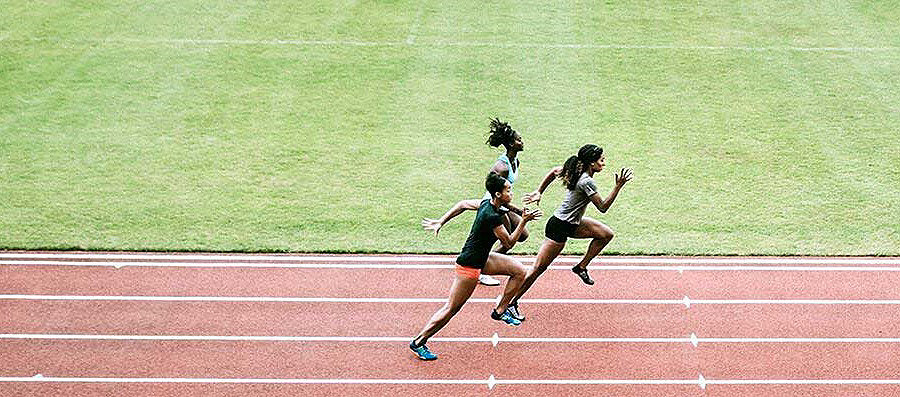From youth leagues to pros: AEDs play a vital role in safeguarding athletes of all ages
11-Mar-2024

3-minute read
In the fast-paced world of sports, where victories and challenges unfold on the field, athletes face a silent and unpredictable adversary—sudden cardiac arrest. This life-threatening condition knows no age or athletic level, impacting young individuals engaged in youth sports to professionals performing at their peak.
Automated external defibrillators (AEDs) are a vital safeguard within the domain of sports, spotlighting the urgent need for increased awareness, widespread accessibility and proactive preparedness about AEDs. Having AEDs readily available near all sporting events regardless of level of play can aid in mitigating the dire consequences potentially arising from a sudden cardiac event, thereby ensuring the safety and well-being of our athletes who give their all on the field.1
Sudden cardiac arrest: an unpredictable threat
The unpredictable nature of sudden cardiac arrest magnifies the critical need for AEDs to be immediately accessible in all sports facilities. In recent years, we’ve witnessed alarming examples in both professional and amateur sports. High-profile instances in professional football and college basketball have drawn significant media attention, demonstrating the severity of these incidents and their potential to strike even those at the peak of their physical fitness. Furthermore, the issue is not confined to the world of professional sports alone. Tragic instances have also occurred in the realm of youth sports. A poignant example is the 12-year-old girl who suffered a sudden cardiac arrest during a routine soccer practice session in Arizona in 2023.2
These examples, though distressing, are crucial in highlighting the indiscriminate nature of cardiac arrest. It does not differentiate on the basis of age or physical prowess, reinforcing the need for the availability of life-saving AEDs in sports facilities. The unpredictability of such events necessitates a proactive approach towards ensuring the safety of all athletes, which means having the right equipment accessible at the right time.
CPR and AEDs: bridging critical moments
Cardiopulmonary Resuscitation (CPR) is a basic life-saving procedure designed to simulate the pumping of the heart through manual chest compressions to maintain circulation and oxygenation of the body during cardiac arrest. While immediate initiation of good quality CPR has been shown to significantly improve survival rates and outcomes of cardiac arrest, the effectiveness of CPR in cardiac arrest scenarios is greatly enhanced when it is combined with the use of an AED.3
The use of CPR and AEDs during cardiac arrest is pivotal in bridging the critical moments between an incident and advanced life-saving intervention from a medical professional. With more than 350,000 out of hospital sudden cardiac arrests annually in the U.S. and 90 percent of them fatal, time between the incident and first shock is critical.4 Each minute of delay between the cardiac arrest and defibrillation reduces the probability of survival by 10 percent.5
Fortunately, AEDs are designed to be user-friendly, helping bystanders take immediate action in high-stress situations on the sports field or court. The simplicity of operating most AEDs can significantly reduce intervention time, making them invaluable tools in the race against the potentially devastating consequences of sudden cardiac arrest.
Advocacy for cardiac arrest awareness and AED accessibility
Campaigns promoting cardiac screening for athletes can help contribute to a culture of preparedness within the athletics community. The American Academy of Pediatrics (AAP) emphasizes the importance of cardiac screening for young individuals regardless of their activity level.6 Routine screenings can help identify potential cardiac issues before they escalate. Integrating these screenings into regular health check-ups for young individuals engaged in sports is a proactive step in helping prevent cardiac arrest.5
Coaches, athletes, parents and even spectators should be well-versed in the importance of AEDs and their effective usage. Education and training are key components of creating a safer athletic environment, ensuring individuals are equipped to respond swiftly and effectively to cardiac arrest.
In addition to education, widespread accessibility to AEDs is a fundamental aspect of successful emergency response planning. Advocating for the strategic placement of AEDs within sports arenas, gyms and playing fields is an investment in the well-being of participants and spectators alike.
Collaborative efforts for well-being
Recognizing the crucial role of AEDs in athletics is vital. The sports community should collaborate to raise awareness, advocate for AED accessibility and prioritize readiness. By embracing these principles, individuals of all ages can relish the excitement of sports in an environment that values their well-being and safety. As we navigate the unpredictable nature of sudden cardiac arrest, let's stand united in our commitment to safeguarding the hearts that beat for the love of the game.
Together, we save lives.
The decision to invest in an AED is an important one that could save lives. Choosing the safest device for your environment and population is crucial.
Connect with an AED expert to learn more about our AEDs and how we can help make your athletic facilities safer.
Learn More
Knowing when to use an AED: Guidelines for sudden cardiac arrest
1. Rothmier, J. D., & Drezner, J. A. (2009). The role of automated external defibrillators in athletics. Sports health, 1(1), 16–20.
2. Steinbuch Y, Arizona girl, 12 saved by teammates mom after suffering sudden cardiac arrest during soccer, New York Post, Published May 1, 2023. Available at: https://nypost.com/2023/05/01/arizona-girl-12-suffers-cardiac-arrest-during-soccer-practice
3. Page R. L. (2011). The AED in resuscitation: it's not just about the shock. Transactions of the American Clinical and Climatological Association, 122, 347–355.
4. American Heart Association Heart and Stroke Statistics – 2022 Update highlights, Sudden Cardiac Arrest Foundation, Available at: https://www.sca-aware.org/about-sudden-cardiac-arrest/latest-statistics
5. Medical Advisory Secretariat (2005). Use of automated external defibrillators in cardiac arrest: an evidence-based analysis. Ontario health technology assessment series, 5(19), 1–29.
6. Robert Campell, Stuart Berger, Michael J. Ackerman, W. Robert Morrow, Kathy Jenkins, L. LuAnn Minich, Geoffrey L. Rosenthal, Christopher S. Snyder, James Twedell; Pediatric Sudden Cardiac Arrest. Pediatrics April 2012; 129 (4): e1094–e1102. 10.1542/peds.2012-0144
M0000017580 REV AA
